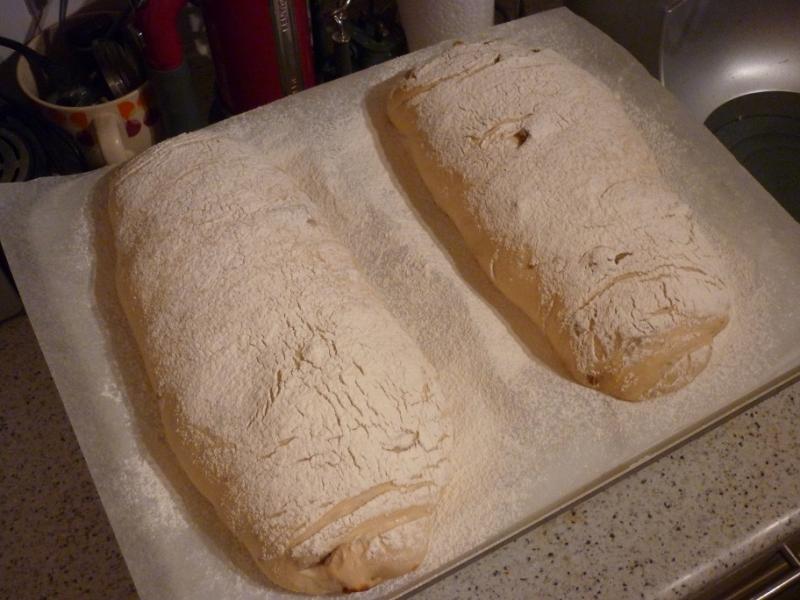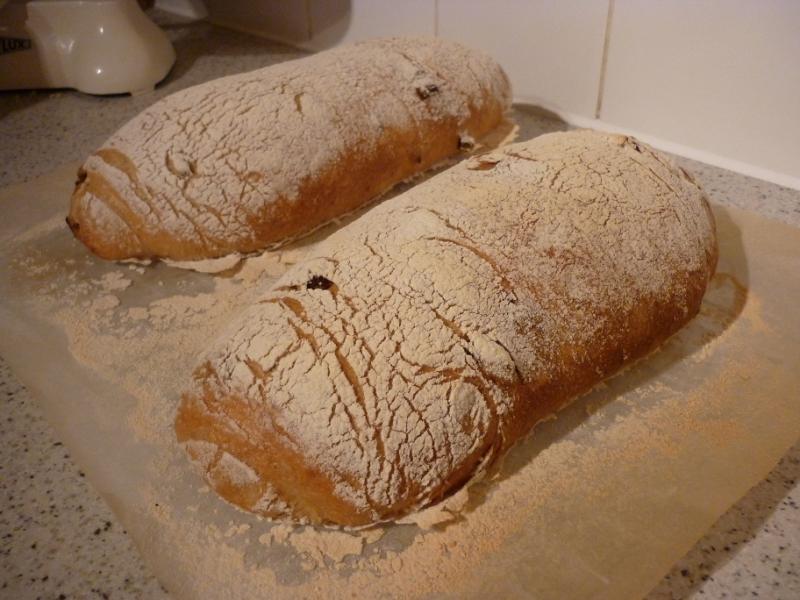Flavoured Ciabatta made using traditional methods. Suitable for sandwiches.
Traditional Biga - left to ferment for approx 15hrs at cool room temp.
300g '00' Flour, medium strength
150g cold water
1.1g Instant yeast
Final Dough - kept warm at 28c.
420g Biga
70g '00' Flour, medium strength
4g Malt Powder
7g salt
140g water
28g good quality extra-virgin olive oil.
sun-dried tomatoes to taste
Method
Mix biga by hand using downward pressure to a smooth, dry dough. Leave at room temp overnight for about 15hrs.
Next day, cut the big into pieces add malt powder, flour and an equal amount of water. Mix until smooth. Continue mixing adding the remaining water in stages. Add salt with the last of the water. Finally add the oil and mix to full gluten development before folding in the tomatoes.
Place dough in a well oiled flat and wide container. Leave to rise at warm temp (~28C). Stretch and fold at 30 min intervals until the dough is strong enough to sit high. Wait until almost double in size (~3hrs) before dividing in two.
Leave pieces to rest for 20 mins before shaping like a business letter. Dust with more flour and proof until double with cracks in the flour (~2hrs)
Bake.
Proofed:
Total dough volume is approx 4 times that of the mixed dough.
Baked:
Oven spring was great as with any well made ciabatta, rising vertically, swelling like a balloon.
Crumb:
Extremely soft and porous crumb.
Michael
- mwilson's Blog
- Log in or register to post comments
Hi Michael,
Do you mix in a machine at home, or, by hand for Ciabatta? Your mixing method seems similar to "bassinage", but not exactly like it.
Do you slide the loaves onto a pre-heated stone when it comes to baking?
I always do these with a stiff biga too; beautiful result.
Best wishes
Andy
Thanks Andy.
I mix by machine and the method of gradually adding water is typical of Italian bakers. With my planetary mixer though it takes a while to incorporate the added water each time. That, combined with my preferred low mixing speeds means mixing time was almost an hour! After mixing I did perform a few slap and folds just to prove I'd reached maximum extension.
I have a cast iron stone which I pre-heat on the hobs but it can only take one loaf at a time so I just put a tray on top on this occasion.
For me this is the most traditional way to make Ciabatta.
Thanks again.
Michael
would it work with 'normal' bread flour? I've not made ciabatta with '00'..
and the malt powder - is that essential? and would it work with the malt extract liquid, as an alternative? I've read about diastatic & non-diastatic...so am I right in saying that the liquid malt is non-, and the powder is just diastatic
sorry to ask such dumb questions...
Not dumb questions at all.
I prefer weaker flours for ciabatta as it's more traditional and it makes the final product very brittle when toasted - which is just delightful when used for bruschetta. You can use bread flour although I would up the final hydration from 80 to 85% to get a dough of equivalent properties.
I use malt for flavour and just to make sure the yeast has plenty of food since the pre-ferment is so large. Malt powder is available as diastatic and non-diastatic. I used non-diastatic. Liquid malt is non-diastaic too and is a perfect substitute in this case.
Hi Michael,
I'm happy to use the strong flour in the Biga, but then compensate by using weaker flour in the final dough.
I tend to use a portion of yeast in the final dough for pretty much the same insurance you use the malt. If you chose to use Diastatic Malt Powder, maybe 1.5g would be better than 4g, as the amount is so critical for diastatic?
I'm just wondering if you switch from hook to paddle as you add the extra water, which is how I prefer to mix. If not, you may find this will speed things up a tad.
All good wishes
Andy
There certainly is a tipping point where the flour can be too weak for the biga. But this '00' is up to it. I really wish Shipton Mill would supply W values or even a protein content on their flour, a great Miller otherwise.
Sure I would use less malt if I were using diastatic. But I am leaning towards flavour but with the added insurance.
I might try that with paddle. Thanks for the tip.
Michael
Great ciabatta and I found your method informative, too. I have some 00 flour on hand and might just give this a go on the weekend.
Best,
Syd
Cheers Syd.
'00' flour can vary greatly so you'll most likely have to adjust water accordingly. The Biga should be thick and dry. The final dough should be slack but not runny. Hope this helps.
some very nice ciabatta. Don't know if could mix an hour, on 1 without the KA dropping dead - even with a high hydration dough dough like this :-) Don't know if I have the patience either. I think I would do S&F's instead. Could one use Barley Malt syrup in place of the malt powder?
Thank you.
Slap & fold would be the preferred technique for hand mixing. To stay true to the recipe, make sure you reach full gluten development.
All malt comes from barley and your syrup is perfect for this recipe.
Michael
Hi Michael,
Your Ciabatta look amazing! Perfect timing, I just ran out of bread flour and only have '00' flour in my pantry. I just made the Biga and was wondering what temperature you cooked them at?
Cheers Sonia
Hi Sonia,
I cooked them at the highest temperature possible. My oven tops out at 230C (450F) but I did also pre-heat a cast iron stone on the hobs to about 600F.
Please let me know how it goes.
Many thanks
Michael
Thank you and I will :)
Michael I had so much fun making your Ciabatta recipe today! I'm not an experienced baker and when I saw the high hydration of the dough when mixing in my Kenwood mixer I FREAKED OUT LOL. But I took a breath and stuck to your recipe and sure enough I ended up with a workable dough (shock)!!!
I was so focused on watching the dough mix that I put the plug into my kitchen sink too wash dishes and totally forgot the water was running! At this point I thought, gosh I'm having a bad day and have no hope of my bread turning out! lol
Totally shocked me that in 3 hours I had a workable dough!
At this point I thought I'm never going to end up with a loaf as high as yours, but boy it had great oven spring.
Thanks so much for taking the time to share your recipe.........I used garlic infused olive oil and the bread turned out fantastic and we are eating it tonight with Fettuccine Amatriciana ....YUM!
Thanks so much! Sonia :)
Sonia they look great! I'm so pleased you managed to follow my recipe.
When I mix this dough sure enough I'll be completely focused, staring into the mixing bowl waiting before adding more water... Everything else just gets forgotten.
Great pics showing the various stages.
Nice choice with garlic, I personally love garlic. I like to toast a slice and rub it lightly with a clove.
Glad you got a great result. But most of all I'm glad you had fun!
Really chuffed,
Michael
I will definetly be making these again, they tasted fantastic!
I was actually reading another recipes on TFL yesterday
http://www.thefreshloaf.com/node/27567/kuta-sourdough-whole-wheat-tweak-susans-norwich-sd
Lee shared a You Tube link on how to use Lava Rocks to create steam (complete with safety warnings).......I ran outside to our sauna and stole the lava rocks and used them, boy they really create STEAM :D
Cool. I have a similar setup although I use ceramic baking beans and they work very well indeed. Wish I had a sauna!
I didn't mention it but I did cook these ciabatta breads with steam.
I wonder what flavour(s) you'll choose for the next batch...
Michael
This recipe is now on my blog @ http://staffoflife.wordpress.com